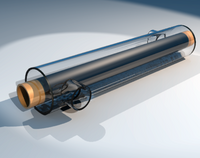
Photo from wikipedia
In this paper, the effect of different channel spacing in spiral heat exchanger filled with Cu–ZnO–water hybrid nanofluid was investigated to find the optimum thermal–hydraulic performance. The hot water flow… Click to show full abstract
In this paper, the effect of different channel spacing in spiral heat exchanger filled with Cu–ZnO–water hybrid nanofluid was investigated to find the optimum thermal–hydraulic performance. The hot water flow enters into the test section from central aperture of heat exchanger, and the cold hybrid nanofluid flow enters into the test section from the outer aperture of the heat exchanger. The effects of different flow velocities, nanoparticles φ and channel spacing values have been analyzed. Results have been presented on Nusselt number, outlet temperature, pressure drop and PEC. According to the obtained results, channel spacing decrease in constant flow velocity values is more effective than volume fraction increase on outlet temperature improvement. Also, an increase in inlet flow velocity leads to lower heat transfer between cold and hot channels, but the growth of volume fraction can improve the thermal efficiency of the heat exchanger at high velocities. On the other hand, the reduction in channel spacing leads to more pressure drop penalty. Especially for the hot water flow, this behavior reduces the hydraulic performance of heat exchanger. The less the channel spacing, the more the pressure drop. The highest average Nusselt number occurs at a velocity of 0.45 (m s −1 ) and φ = 4% at a channel spacing of 35 mm. The maximum value of the pressure drop occurs at b = 2.5–5 mm. Besides considering the PEC value, 2% volume fraction is recommended for the spiral heat exchanger.
Journal Title: Journal of Thermal Analysis and Calorimetry
Year Published: 2020
Link to full text (if available)
Share on Social Media: Sign Up to like & get
recommendations!